LG AS-W1264GH0, AS-W0964GH0, AS-W1865DH0, AS-W091264DH0, AS-W1424DH0 Manual

website http://www.lgservice.com
LG
LG
Room Air Conditioner
SERVICE MANUAL
MODELS: AS-W0964DH0
AS-W1264DH0
AS-W1865DH0
AS-W0964GH0
AS-W1264GH0
AS-W1224DH0
AS-W1424DH0
AS-W1825DH0
CAUTION
•BEFORE SERVICING THE UNIT, READ THE SAFETY PRECAUTIONS IN THIS MANUAL.
•ONLY FOR AUTHORIZED SERVICE PERSONNEL.

Air Conditioner Service Manual
TABLE OF CONTENTS
LG Model Name................................................................................................................................. |
3 |
Safety Precautions ........................................................................................................................... |
5 |
Dimensions ..................................................................................................................................... |
10 |
Installation....................................................................................................................................... |
14 |
Flaring work and connection of piping......................................................................................... |
16 |
Connecting the cable between indoor unit and outdoor unit..................................................... |
21 |
Checking the drainage and forming the pipings ......................................................................... |
23 |
Air purging ...................................................................................................................................... |
24 |
Test running .................................................................................................................................... |
26 |
Functions......................................................................................................................................... |
27 |
Operation......................................................................................................................................... |
30 |
Disassembly.................................................................................................................................... |
41 |
Troubleshooting Guide .................................................................................................................. |
44 |
Schematic Diagram ........................................................................................................................ |
65 |
Product Specifications .................................................................................................................. |
73 |
Exploded View ................................................................................................................................ |
75 |
Replacement Parts List .................................................................................................................. |
78 |
2 Room Air Conditioner

LG Model Name
LG Model Name

 2003
2003
























































|
1 |
|
2 |
|
- |
|
3 |
4 |
5 |
6 |
7 |
|
8 |
|
9 |
10 |
|
|
|
|
|
|
|
|
|
|
|
|
|
|
|
|
|
|
|
|
|
|
|
|
|
|
|
|
|
|
|
|
|
||
Code |
|
Type |
|
Code of Model |
|
|
|
Meaning |
|
|
|
|
|
|
|
|
|||||||||
|
|
|
|
|
|
|
|
|
|
|
|
|
|
|
|
|
|
||||||||
1 |
|
|
Producing Center, |
|
A~Z |
|
|
L: Chang-won R22 |
|
N: India |
|
|
|
||||||||||||
|
|
|
|
Refrigerant |
|
|
|
|
|
A: Chang-won R410A |
|
Z: Brazil |
|
|
|
||||||||||
|
|
|
|
|
|
|
|
|
|
|
|
C: Chang-won R407C |
|
D: Indonesia |
|
|
|
||||||||
|
|
|
|
|
|
|
|
|
|
|
|
T: China |
|
|
|
M: Mexico |
|
|
|
||||||
|
|
|
|
|
|
|
|
|
|
|
|
K: Turkey R22 |
|
|
|
V: Vietnam |
|
|
|
||||||
|
|
|
|
|
|
|
|
|
|
|
|
E: Turkey R410A |
|
S: Out Sourcing |
|
|
|
||||||||
|
|
|
|
|
|
|
|
|
|
|
|
H: Thailand |
|
|
|
|
|
|
|
|
|
|
|||
2 |
|
|
Product Type |
|
A~Z |
|
|
S: Split Type Air Conditioner |
|
|
|
||||||||||||||
3 |
|
Cooling/Heating/Inverter |
A~Z |
|
|
C: Cooling only |
|
V: AC Inverter C/O |
|
|
|
||||||||||||||
|
|
|
|
|
|
|
|
|
|
|
|
H: Heat pump |
|
|
|
N: AC Inverter H/P |
|
|
|
||||||
|
|
|
|
|
|
|
|
|
|
|
|
X: C/O + E/Heater |
|
Q: DC Inverter C/O |
|
|
|
||||||||
|
|
|
|
|
|
|
|
|
|
|
|
Z: H/P + E/Heater |
|
W: DC Inverter H/P |
|
|
|
||||||||
4, 5 |
|
|
|
Capacity |
|
|
0~9 |
|
|
Cooling/Heating Capacity |
|
|
|
||||||||||||
|
|
|
|
|
|
|
|
|
|
|
|
Ex. "09" → 9,000 Btu/h |
|
|
|
|
|
|
|
|
|||||
6 |
|
|
Electric Range |
|
1~9 |
|
|
1: 115V/60Hz, |
|
|
A: 220V, 50Hz, 3Phase |
|
|
|
|||||||||||
|
|
|
|
|
|
|
|
|
A~Z |
|
|
2: 220V/60Hz |
|
|
B: 208~230V, 60Hz, 3Phase |
|
|
|
|||||||
|
|
|
|
|
|
|
|
|
|
|
|
3: 208-230V/60Hz |
C: 575V, 50Hz, 3Phase |
|
|
|
|||||||||
|
|
|
|
|
|
|
|
|
|
|
|
5: 200-220V/50Hz |
D: 440~460, 60Hz, 3Phase |
|
|
|
|||||||||
|
|
|
|
|
|
|
|
|
|
|
|
6: 220-240V/50Hz |
E: 265V, 60Hz |
|
|
|
|||||||||
|
|
|
|
|
|
|
|
|
|
|
|
7: 110V, 50/60Hz |
F: 200V, 50/60Hz |
|
|
|
|||||||||
|
|
|
|
|
|
|
|
|
|
|
|
8: 380-415V/50Hz |
|
|
|
|
|
|
|
|
|||||
|
|
|
|
|
|
|
|
|
|
|
|
9: 380-415V/60Hz |
|
|
|
|
|
|
|
|
|||||
7 |
|
|
|
Chassis |
|
|
A~Z |
|
|
Name of Chassis of Unit |
|
|
|
|
|
|
|
|
|||||||
|
|
|
|
|
|
|
|
|
|
|
|
Ex. LSP → SP Chassis |
|
|
|
|
|
|
|
|
|||||
8 |
|
|
|
|
Look |
|
|
A~Z |
|
|
Look, |
|
|
|
|
|
|
|
|
|
|
|
|
||
|
|
|
|
|
|
|
|
|
|
|
|
Color (Artcool Model) |
|
|
|
|
|
|
|
|
|||||
9 |
|
|
|
Function |
|
|
A~Z |
|
|
|
|
|
|
|
|
|
|
|
|
|
|
|
|||
|
|
|
|
|
|
|
Basic |
|
|
|
|
|
|
|
|
|
|
A |
|
||||||
|
|
|
|
|
|
|
|
|
|
|
|
Basic+4Way |
|
|
|
|
|
|
|
|
B |
|
|||
|
|
|
|
|
|
|
|
|
|
|
|
Plasma Filter |
|
|
|
|
|
|
|
|
C |
|
|||
|
|
|
|
|
|
|
|
|
|
|
|
Plasma Filter+4 Way |
|
|
|
|
|
|
D |
|
|||||
|
|
|
|
|
|
|
|
|
|
|
|
Tele+LCD |
|
|
|
|
|
|
|
|
E |
|
|||
|
|
|
|
|
|
|
|
|
|
|
|
Tele+LCD+Nano plasma+4Way |
|
F |
|
||||||||||
|
|
|
|
|
|
|
|
|
|
|
|
Nano Plasma F+(A/changeove)+A/clean+Low A |
|
G |
|
||||||||||
|
|
|
|
|
|
|
|
|
|
|
|
Nano Plasma F+(A/changeove)+A/clean+4way+Low A |
|
H |
|
||||||||||
|
|
|
|
|
|
|
|
|
|
|
|
Tele+LED+4way |
|
|
|
|
|
|
I |
|
|||||
|
|
|
|
|
|
|
|
|
|
|
|
Internet |
|
|
|
|
|
|
|
|
J |
|
|||
|
|
|
|
|
|
|
|
|
|
|
|
Plasma F+4Way+Oxy generator |
|
K |
|
||||||||||
|
|
|
|
|
|
|
|
|
|
|
|
Nano Plasma F+(A/changeove)+A/clean |
|
L |
|
||||||||||
|
|
|
|
|
|
|
|
|
|
|
|
Nano Plasma F+(A/changeove)+A/clean+4way |
|
M |
|
||||||||||
|
|
|
|
|
|
|
|
|
|
|
|
Nano Plasma F+(A/changeove)+A/clean+PTC |
|
N |
|
||||||||||
|
|
|
|
|
|
|
|
|
|
|
|
Nano Plasma F+(A/changeove)+Autoclean+4way+PTC |
|
P |
|
||||||||||
|
|
|
|
|
|
|
|
|
|
|
|
Nano Plasma F+(A/changeove)+A/clean+4way+Low A+PTC |
|
Q |
|
||||||||||
|
|
|
|
|
|
|
|
|
|
|
|
Negative ION+A/Clean |
|
|
|
|
|
|
R |
|
|||||
|
|
|
|
|
|
|
|
|
|
|
|
(Nano)Plasma+Negative ION+A/Clean |
|
S |
|
||||||||||
|
|
|
|
|
|
|
|
|
|
|
|
4way+(Nano)Plasma F+Negative ION+Healthy dehumidification+A/Clean |
T |
|
|||||||||||
|
|
|
|
|
|
|
|
|
|
|
|
Nano Plasma F+4Way+(A/changeove)+A/clean+ |
|
U |
|
||||||||||
10 |
|
|
|
Serial No. |
|
|
0~9 |
|
|
LG Model Development Serial No. |
|
|
|
||||||||||||
|
|
|
|
|
|
|
|
|
|
|
|
* ARTCOOL COLOR |
|
|
|
|
|
|
|
|
|||||
|
|
|
|
|
|
|
|
|
|
|
|
|
|
|
|
|
|
|
|
|
|
|
|
|
|
|
|
|
|
|
|
|
|
|
|
|
|
R |
|
|
|
Mirror |
|
|
|
N |
|
Walnut |
|
|
|
|
|
|
|
|
|
|
|
|
|
|
|
W |
|
|
|
White |
|
|
|
A |
|
Gogh |
|
|
|
|
|
|
|
|
|
|
|
|
|
|
|
B |
|
|
|
Blue |
|
|
|
S |
|
Sisley |
|
|
|
|
|
|
|
|
|
|
|
|
|
|
|
D |
|
|
|
Wood |
|
|
|
Q |
|
Quran |
|
|
|
|
|
|
|
|
|
|
|
|
|
|
|
M |
|
|
|
Metal |
|
|
|
K |
|
Mecca |
|
|
|
|
|
|
|
|
|
|
|
|
|
|
|
C |
|
|
Cherry |
|
|
|
|
|
|
|
|
||
Service Manual 3

LG Model Name

 2004~
2004~





































































|
1 |
2 |
|
- |
|
3 |
4 |
5 |
6 |
|
7 |
|
8 |
|
9 |
10 |
|
|
|
|
||
|
|
|
|
|
|
|
|
|
|
|
|
|
|
|
|
|
|
|
|
|
||
Code |
Type |
|
Code of Model |
|
|
|
Meaning |
|
|
|
|
|||||||||||
|
|
|
|
|
|
|
|
|
|
|
|
|
|
|||||||||
|
|
|
|
|
|
|
|
|
|
|
|
|
|
|||||||||
1 |
|
Producing Center, |
|
A~Z |
|
L |
|
|
Chang_won R22 |
|
N |
India |
|
|||||||||
|
|
|
Refrigerant |
|
|
|
|
A |
|
|
Chang_won R410A |
|
Z |
Brazil |
|
|||||||
|
|
|
|
|
|
|
|
|
|
C |
|
|
Chang_won R407C |
|
D |
Indonesia |
|
|||||
|
|
|
|
|
|
|
|
|
|
T |
|
|
China |
|
|
|
X |
Mexico |
|
|||
|
|
|
|
|
|
|
|
|
|
K |
|
|
Turkey R22 |
|
|
|
V |
Vietnam |
|
|||
|
|
|
|
|
|
|
|
|
|
E |
|
|
Turkey R410A |
|
S |
Out sourcing |
|
|||||
|
|
|
|
|
|
|
|
|
|
H |
|
|
Thailand |
|
|
|
|
|
|
|
||
2 |
Product Type |
A~Z |
S: Split Type Air Conditioner |
|
|
|
|
|||||||
3 |
Cooling/Heating/Inverter |
A~Z |
C: Cooling only |
|
V: AC Inverter C/O |
|
|
|
||||||
|
|
|
H: Heat pump |
|
N: AC Inverter H/P |
|
|
|
||||||
|
|
|
X: C/O + E/Heater |
|
Q: DC Inverter C/O |
|
|
|
||||||
|
|
|
Z: H/P + E/Heater |
|
W: DC Inverter H/P |
|
|
|
||||||
4, 5 |
Capacity |
0~9 |
Cooling/Heating Capacity |
|
|
|
|
|||||||
|
|
|
Ex. "09" → 9,000 Btu/h |
|
|
|
|
|
|
|
|
|
||
6 |
Electric Range |
1~9 |
1: 115V/60Hz, |
|
A: 220V, 50Hz, 3Phase |
|
|
|
||||||
|
|
A~Z |
2: 220V/60Hz |
|
B: 208~230V, 60Hz, 3Phase |
|
||||||||
|
|
|
3: 208-230V/60Hz |
|
C: 575V, 50Hz, 3Phase |
|
|
|
||||||
|
|
|
5: 200-220V/50Hz |
|
D: 440~460, 60Hz, 3Phase |
|
||||||||
|
|
|
6: 220-240V/50Hz |
|
E: 265V, 60Hz |
|
|
|
|
|||||
|
|
|
7: 110V, 50/60Hz |
|
F: 200V, 50/60Hz |
|
|
|
||||||
|
|
|
8: 380-415V/50Hz |
|
|
|
|
|
|
|
|
|
|
|
|
|
|
9: 380-415V/60Hz |
|
|
|
|
|
|
|
|
|
|
|
|
|
|
|
|
CHASSIS |
|
Look |
Division |
|
|||||
|
|
|
|
|
|
|
|
|
||||||
7 |
Chassis |
A~Z |
Name of Chassis of Unit |
|
S4/S5 |
|
D |
Panel Type(Deluxe) |
||||||
|
S6 |
|
K |
Fighting 'Look' |
|
|||||||||
|
|
|
Ex. LSP → SP Chassis |
|
|
|
||||||||
|
|
|
|
SQ |
|
L |
(LG1) |
|
||||||
8 |
Look |
A~Z |
Look, |
|
|
|
|
|||||||
|
|
SR |
|
G |
(LG2)-SEMI PANEL |
|||||||||
|
|
|
Color (Artcool Model) |
|
ST |
|
M |
OEM1 |
|
|||||
|
|
|
|
|
|
|
|
|
|
|
N |
OEM2 |
|
|
|
|
|
|
|
|
|
|
|
|
|
D |
Panel Type(Deluxe) |
||
|
|
|
|
|
|
|
|
|
|
|
P |
LG3 |
|
|
9 |
Function |
A~Z |
|
|
|
|
|
|
|
|
|
|
|
|
Basic |
|
|
|
|
|
|
|
|
|
A |
||||
|
|
|
Basic+4Way |
|
|
|
|
|
|
|
|
|
B |
|
|
|
|
Plasma Filter |
|
|
|
|
|
|
|
|
|
C |
|
|
|
|
Plasma Filter+4 Way |
|
|
|
|
|
|
|
|
D |
||
|
|
|
Tele+LCD |
|
|
|
|
|
|
|
|
|
E |
|
|
|
|
Tele+LCD+Nano plasma+4Way |
|
|
|
F |
|||||||
|
|
|
NBF F+(A/changeove)+A/clean+Low A |
|
|
|
G |
|||||||
|
|
|
NBF F+(A/changeove)+A/clean+4way+Low A |
|
|
|
H |
|||||||
|
|
|
Tele+LED+4way |
|
|
|
|
|
|
|
|
|
I |
|
|
|
|
Internet |
|
|
|
|
|
|
|
|
|
J |
|
|
|
|
Plasma F+4Way+Oxy generator |
|
|
|
K |
|||||||
|
|
|
NBF F+(A/changeove)+A/clean |
|
|
|
L |
|||||||
|
|
|
NBF F+(A/changeove)+A/clean+4way |
|
|
|
M |
|||||||
|
|
|
NBF F+(A/changeove)+A/clean+PTC |
|
|
|
N |
|||||||
|
|
|
NBF F+(A/changeove)+Autoclean+4way+PTC |
|
|
|
P |
|||||||
|
|
|
NBF F+(A/changeove)+A/clean+4way+Low A+PTC |
|
|
Q |
||||||||
|
|
|
(Nano)Plasma+ION+A/Clean |
|
|
|
S |
|||||||
|
|
|
4way+(Nano)Plasma F+Negative ION+Healthy dehumidification+A/Clean |
|
T |
|||||||||
|
|
|
Nano Plasma F+4Way+(A/changeove)+A/clean+Oxy generator |
|
U |
|||||||||
|
|
|
4way+(Nano)Plasma F+Negative ION+Healthy dehumidification+A/Clean+Oxy generator |
|
V |
|||||||||
|
|
|
Dry contact |
|
|
|
|
|
|
|
|
|
W |
|
|
|
|
Wire remocon |
|
|
|
|
|
|
|
|
|
8 |
|
10 |
Serial No. |
0~9 |
LG Model Development Serial No. |
|
|
|
|
|||||||
|
|
|
* ARTCOOL COLOR |
|
|
|
|
|
|
|
|
|
||
|
|
|
|
|
|
|
|
|
|
|
|
|
|
|
|
|
|
R |
|
Mirror |
|
|
|
|
|
|
|
|
|
|
|
|
W |
|
White |
|
|
|
|
|
|
|
|
|
|
|
|
B |
|
Blue |
|
|
|
|
|
|
|
|
|
|
|
|
D |
|
Wood |
|
|
|
|
|
|
|
|
|
|
|
|
M |
|
Metal |
|
|
|
|
|
|
|
|
|
|
|
|
C |
|
Cherry |
|
|
|
|
|
|
|
|
|
4 Room Air Conditioner

Safety Precautions
Safety Precautions
To prevent injury to the user or other people and property damage, the following instructions must be followed.
■Incorrect operation due to ignoring instruction will cause harm or damage. The seriousness is classified by the following indications.
This symbol indicates the possibility of death or serious injury.
This symbol indicates the possibility of injury or damage to properties only.
■ Meanings of symbols used in this manual are as shown below.
Be sure not to do.
Be sure to follow the instruction.
■ Installation
Do not use damaged power cords, plugs, or a loose socket.
• There is risk of fire of electric shock.
Always use the power plug and socket with the ground terminal.
• There is risk of electric shock.
Install the panel and the cover of control box securely.
• There is risk of fire of electric shock.
Do not modify or extend the power cord.
• No grounding may cause electric shock.
Service Manual 5
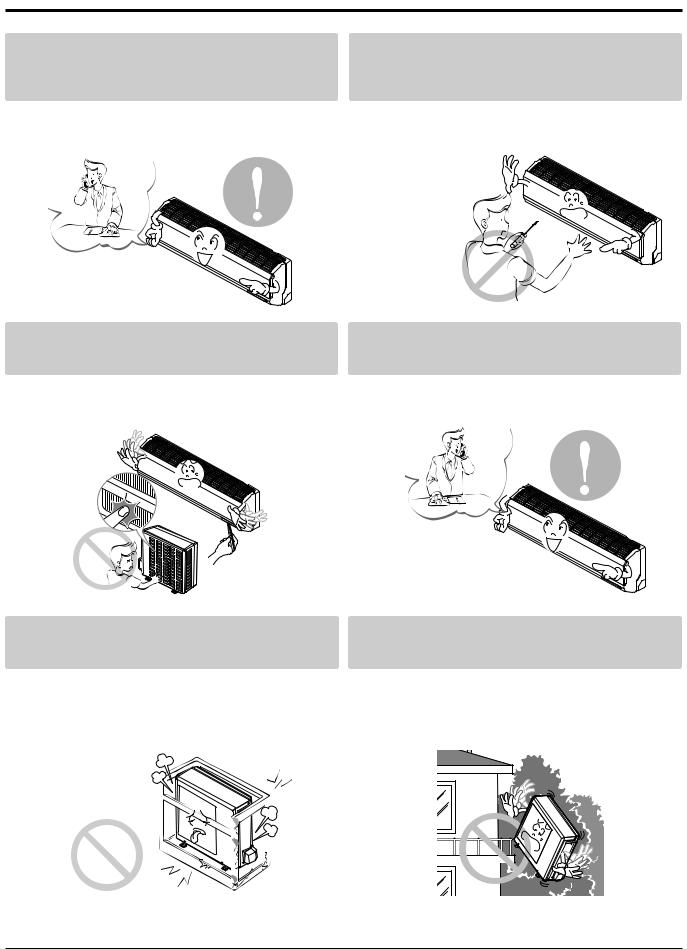
Safety Precautions
For re-installation of the installed product, always contact a dealer or an authorized service center.
•There is risk of fire, electric shock, explosion, or injury.
ful of the case edges and the fins on the condenser and evaporator.
Do not install, remove, or re-install the unit by yourself.
•There is risk of fire, electric shock, explosion, or injury.
For installation, always contact the dealer or an Authorized service center
• There is risk of fire, electric shock, explosion, or injury.
Do not install the product on a defective installation stand.
Be sure the installation area does not deteriorate with age.
•It may cause injury, accident, or damage to the product.
•If the base collapses, the air conditioner could fall with it, causing property damage, product failure, and personal injury.
6 Room Air Conditioner

Safety Precautions
■ Operation
Do not turn the air-conditioner ON or OFF by plugging or unplugging the power plug.
• There is risk of fire or electrical shock.
Grasp the plug to remove the cord from the outlet. Do not touch it with wet hands.
• There is risk of fire or electrical shock.
Do not allow water to run into electrical parts.
Use a dedicated outlet for this appliance.
• There is risk of fire or electrical shock.
Do not place a heater or other appliances near the power cable.
• There is risk of fire and electric shock.
Do not store or use flammable gas or combustibles near the air conditioner.
• There is risk of fire, failure of the product, or electric • There is risk of fire or failure of product. shock.
Wax
Thinner
Service Manual 7
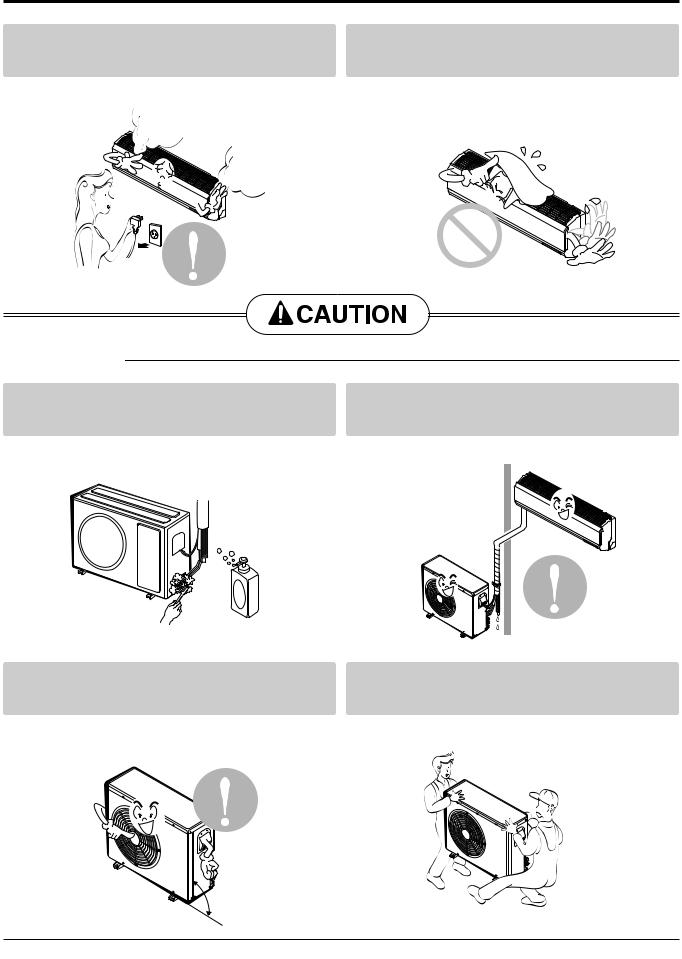
Safety Precautions
Unplug the unit if strange sounds, odors, or smoke comes from it.
• There is risk of electric shock or fire.
Be cautious that water could not enter the product.
•There is risk of fire, electric shock, or product damage.
Always check for gas (refrigerant) leakage after installation or repair of product.
Install the drain hose to ensure that water is drained away properly.
• Low refrigerant levels may cause failure of product. |
• A bad connection may cause water leakage. |
||||
|
|
|
|
|
|
|
|
|
|
|
|
|
|
|
|
|
|
|
|
|
|
|
|
|
|
|
|
|
|
|
|
|
|
|
|
Keep level even when installing the product.
• To avoid vibration or water leakage.
Use two or more people to lift and transport the air conditioner.
• Avoid personal injury.
90˚
8 Room Air Conditioner

Safety Precautions
■ Operation
Use a soft cloth to clean. Do not use harsh detergents, solvents, etc.
Wax
Do not touch the metal parts of the product when removing the air filter. They are very sharp!
• There is risk of personal injury.
Do not step on or put anyting on the product. (outdoor units)
Do not insert hands or other objects through the air inlet or outlet while the air conditioner is plugged in.
• There is risk of personal injury and failure of product. |
• There are sharp and moving parts that could cause |
|
personal injury. |
Service Manual 9
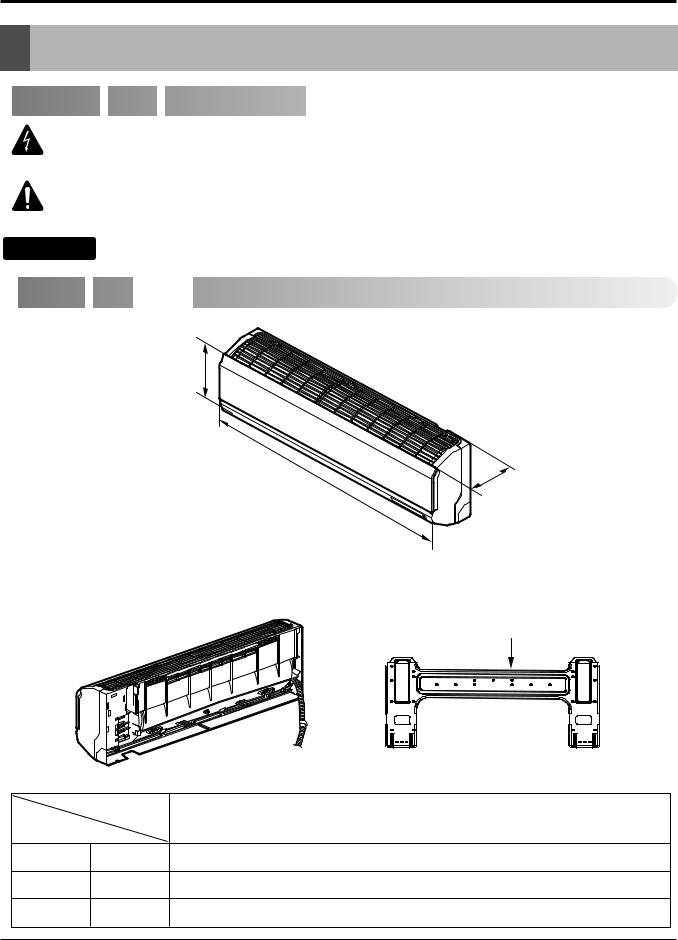
Dimensions
Dimensions

 Symbols
Symbols Used
Used in this Manual
in this Manual










































This symbol alerts you to the risk of electric shock.
This symbol alerts you to hazards that could cause harm to the air conditioner.
NOTICE This symbol indicates special notes.

 Indoor
Indoor Unit
Unit






H
D
W
Installation plate
Model
Dimension |
|
7k, 9k, 12k, 14k Btu Series |
|
|
|
W |
mm |
840 |
H |
mm |
270 |
D |
mm |
153 |
10 Room Air Conditioner
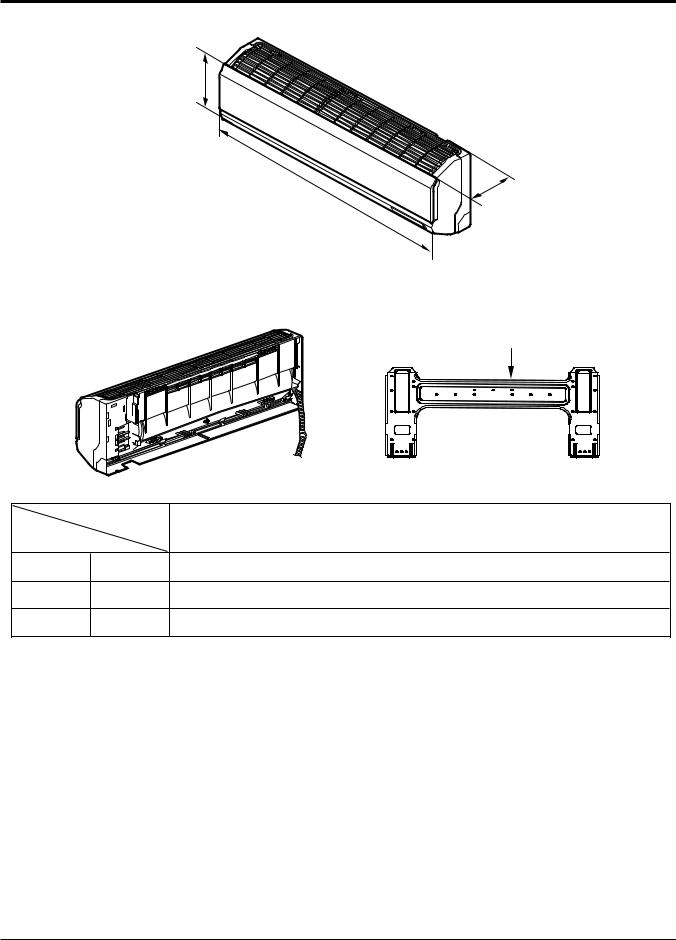
Dimensions
H
D
W
Installation plate
Model
Dimension |
|
18k, 24k Btu Series |
|
|
|
W |
mm |
1090 |
H |
mm |
300 |
D |
mm |
178 |
Service Manual 11
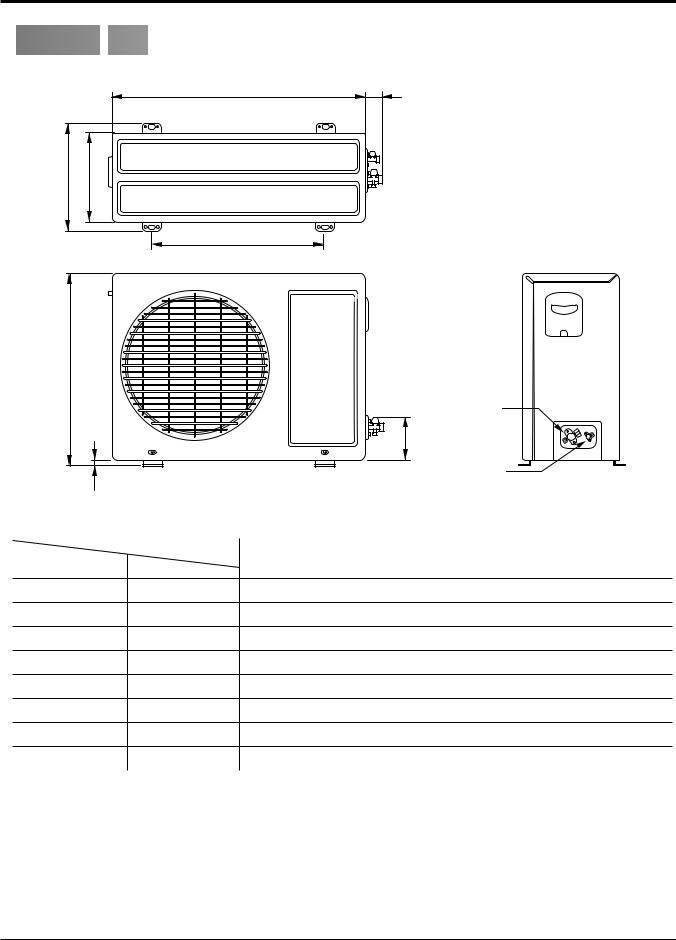
Dimensions

 Outdoor
Outdoor Unit
Unit




























































|
W |
L2 |
L1 |
D |
|
|
L3 |
|
H
L4
Gas side (3-way valve)
L5
Liquid side (2-way valve)
|
MODEL |
9k, 12k, 14k Btu Series |
DIM |
7k, |
|
unit |
|
|
W |
mm |
770 |
H |
mm |
540 |
D |
mm |
245 |
L1 |
mm |
285 |
L2 |
mm |
65 |
L3 |
mm |
518 |
L4 |
mm |
10 |
L5 |
mm |
100 |
|
|
|
12 Room Air Conditioner

H L4
L5
DIM
W
H
D
L1
L2
L3
L4
L5
L6
L7
L8
L9
L10
L11
Dimensions
W
D |
L2 |
L1 |
|
|
|
L3
|
|
|
L10 |
|
|
|
Gas side |
|
|
|
L11 |
|
|
|
Liquid side |
L7 |
L6 |
L8 |
L9 |
|
MODEL |
|
18k, 24k Btu Series |
|
|
|
|
|
mm |
|
870 |
|
mm |
|
655 |
|
mm |
|
320 |
|
mm |
|
370 |
|
mm |
|
340 |
|
mm |
|
25 |
|
mm |
|
630 |
|
mm |
|
25 |
|
mm |
|
546 |
|
mm |
|
162 |
|
mm |
|
162 |
|
mm |
|
54 |
|
mm |
|
74.5 |
|
mm |
|
79 |
Service Manual 13
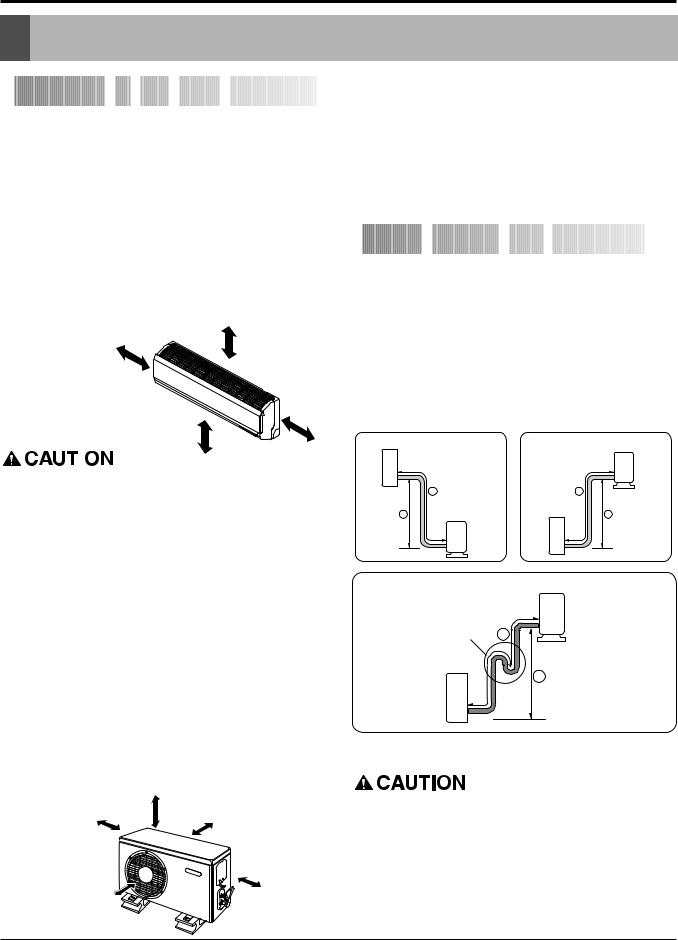
Installation
Installation


 Selection
Selection

 of
of


 the
the
 Best
Best


 Location
Location



Indoor unit
•Do not have any heat or steam near the unit.
•Select a place where there are no obstacles in front of the unit.
•Make sure that condensation drainage can be conveniently routed away.
Do not install near a doorway.
•Ensure that the space around the left and right of the unit is more than "A". The unit should be installed as high on the wall as possible, allowing a minimum of "B" from ceiling.
•Use a stud finder to locate studs to prevent unnecessary
damage to the wall.
10cm
More than 5cm
Rooftop Installations:
•If the outdoor unit is installed on a roof structure, be sure to level the unit. Ensure the roof structure and anchoring method are adequate for the unit location.
•Consult local codes regarding rooftop mounting.


 Piping
Piping

 Length
Length


 and
and
 Elevation
Elevation







Capacity |
Pipe Size |
Standard |
Max. |
Max. |
Additional |
||
|
|
Length |
Elevation |
Length |
Refrigerant |
||
(Btu/h) |
GAS |
LIQUID |
|||||
(m) |
B (m) |
A (m) |
(g/m) |
||||
|
|
|
|
|
|
|
|
5k~14k |
3/8"(Ø9.52) |
1/4"(Ø6.35) |
4 or 7.5 |
7 |
15 |
20 |
|
|
|
|
|
|
|
||
1/2"(Ø12.7) |
1/4"(Ø6.35) |
4 or 7.5 |
7 |
15 |
20 |
||
|
|||||||
|
|
|
|
|
|
|
|
|
1/2"(Ø12.7) |
1/4"(Ø6.35) |
4 or 7.5 |
15 |
30 |
20 |
|
18k~28k |
5/8"(Ø15.88) |
1/4"(Ø6.35) |
4 or 7.5 |
15 |
30 |
20 |
|
|
|
|
|
|
|
|
|
|
5/8"(Ø15.88) |
3/8"(Ø9.52) |
4 or 7.5 |
15 |
30 |
30 |
|
|
|
|
|
|
|
|
|
30k~38k |
5/8"(Ø15.88) |
3/8"(Ø9.52) |
7.5 |
15 |
30 |
30 |
|
|
|
|
|
|
|
||
3/4"(Ø19.05) |
3/8"(Ø9.52) |
7.5 |
15 |
30 |
50 |
||
|
|||||||
|
|
|
|
|
|
|
|
Indoor unit |
Outdoor unit |
|
|
|
|
|
|
|
|
|
|
|
|
Grade |
|
Clearance(cm) |
|
||
|
A |
|
B |
||
|
|
|
|
||
5K~28K |
10 |
|
5 |
||
|
|
|
|
|
|
30K~38K |
30 |
|
12 |
||
Outdoor unit
•If an awning is built over the unit to prevent direct sunlight or rain exposure, make sure that heat radiation from the condenser is not restricted.
•Ensure that the space around the back and sides is more than 10cm. The front of the unit should have more than 70cm of space.
•Do not place animals and plants in the path of the warm air.
•Take the air conditioner weight into account and select a place where noise and vibration are minimum.
•Select a place so that the warm air and noise from the air conditioner do not disturb neighbors.
More than 60cm
More than 10cm |
More than 10cm |
|
A |
|
A |
B |
Outdoor unit |
Indoor unit |
B |
|
Outdoor unit |
I |
|
Oil trap
Indoor
B
If case more than 5m
•Capacity is based on standard length and maximum allowance length is on the basis of reliability.
•Oil trap should be installed every 5~7 meters.
More than 70cm |
More |
|
than 60cm |
||
|
14 Room Air Conditioner
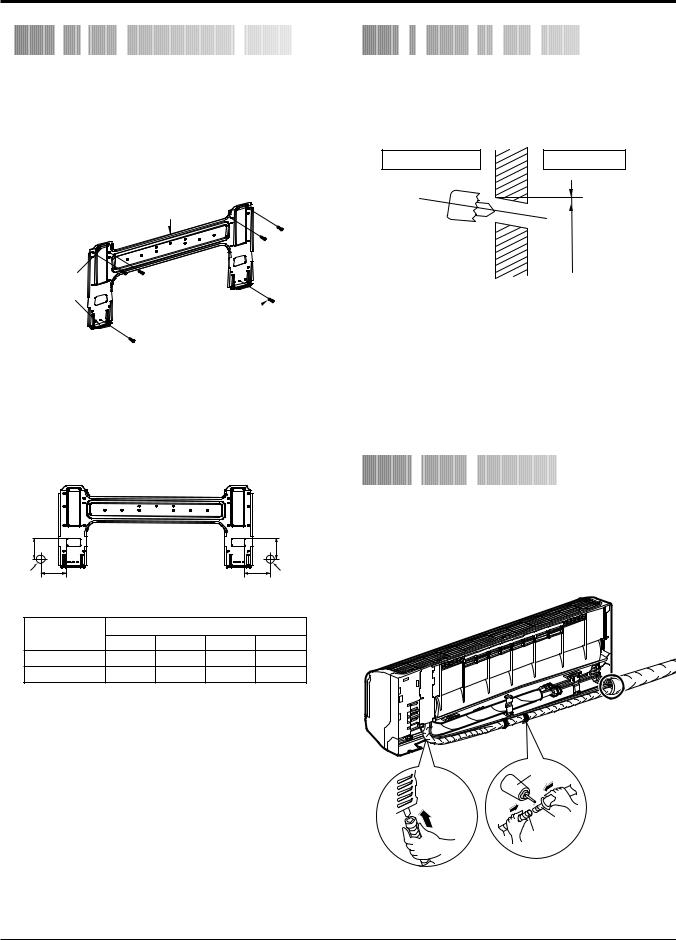
Installation


 How
How

 to
to
 Fix
Fix
 Installation
Installation


 Plate
Plate








The wall you select should be strong and solid enough to prevent vibration
1. Mount the installation plate on the wall with four type A screws. If mounting the unit on a concrete wall, use anchor bolts.
•Mount the installation plate horizontally by aligning the centerline using a level.
Installation Plate
Chassis
Hook
Type "A" screw 
2.Measure the wall and mark the centerline. It is also important to use caution concerning the location of the installation plate-routing of the wiring to power outlets is through the walls typically. Drilling the hole through the wall for piping connections must be done safely.
|
|
Installation plate |
|
|
|
D |
|
|
|
|
B |
Ø70mm |
C |
|
|
A |
Ø70mm |
|
|
|
|
||
|
Left rear piping |
|
|
Right rear piping |
|
|
CHASSIS |
|
Distance (mm) |
|
|
|
(Grade) |
A |
B |
C |
D |
|
|
||||
7k, 9k, 12k, 14k |
75 |
65 |
105 |
65 |
|
|
18k, 24k |
105 |
65 |
260 |
65 |


 Drill
Drill

 a
a


 Hole
Hole
 in
in

 the
the

 Wall
Wall






















•Drill the piping hole with a ø 70mm hole core drill. Drill the piping hole at either the right or the left with the hole slightly slanted to the outdoor side.
|
WALL |
Indoor |
Outdoor |
|
|
|
|
|
|
|
5-7mm |
(3/16"~5/16") |
|
|
|
|||
•Open the Front Grille.
•Pass Telephone Control Cord Wire through the hole which the power cord goes through.
•Connect Telephone Control Cord Wire to the phone jack of telephone PCB of Control Box.
•Fix Telephone Control Cord Wire inside Control box so as not to disconnect.
•Close the Front Grille.


 Drain
Drain

 hose
hose


 junction
junction




























•Remove the rubber stopple in the desired drain direction.
•Insert drain hose into the handle of drain pan, and join drain hose and connecting hose according to the figure by.
Adhesive
Only the desired direction
Connecting
part
Drain
hose
Service Manual 15
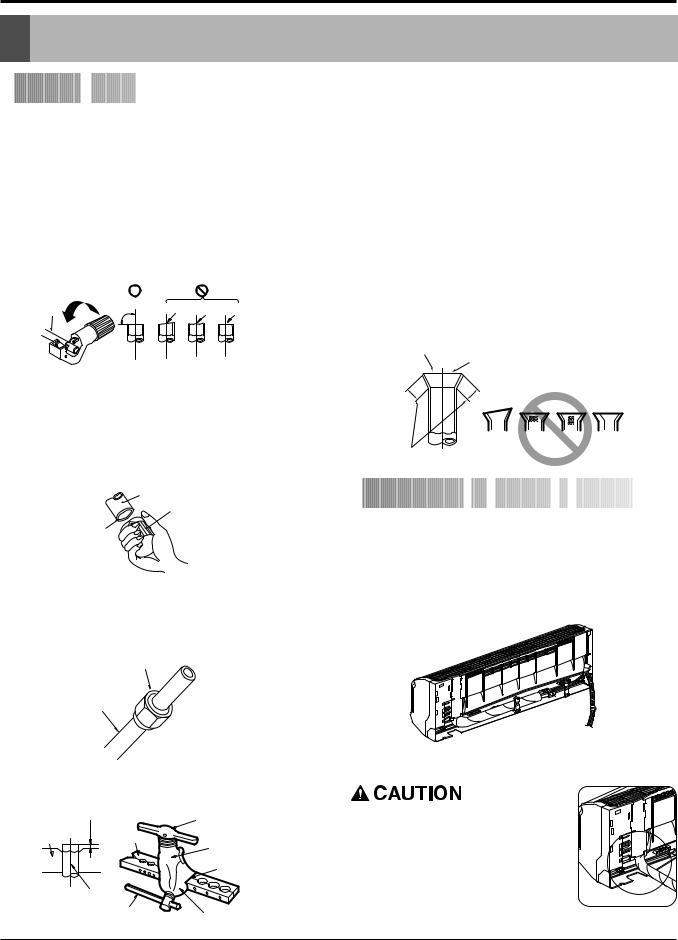
Flaring work and connection of piping
Flaring work and connection of piping


 Flaring
Flaring

 work
work














































Flaring work
Main cause for refrigerant leakage is due to defect in the flaring work. Carry out correct flaring work using the following procedure.
Cut the pipes and the cable.
•Use the piping kit accessory or pipes purchased locally.
•Measure the distance between the indoor and the outdoor unit.
•Cut the pipes a little longer than the measured distance.
•Cut the cable 1.5m longer than the pipe length.
Copper |
|
Slanted Uneven Rough |
pipe |
90° |
Burr removal
•Completely remove all burrs from the cut cross section of pipe/tube.
•Put the end of the copper tube/pipe in a downward direction as you remove burrs in order to avoid dropping burrs into the tubing.
Pipe
Reamer
Point down
Putting nut on
•Remove flare nuts attached to indoor and outdoor unit, then put them on pipe/tube having completed burr removal. (not possible to put them on after flaring work)
Flare nut
Copper tube
• Carry out flaring work using flaring tool as shown below.
Outside diameter |
A |
|
|
|
|
mm |
inch |
mm |
|
|
|
Ø6.35 |
1/4 |
0~0.5 |
|
|
|
Ø9.52 |
3/8 |
0~0.5 |
|
|
|
Ø12.7 |
1/2 |
0~0.5 |
|
|
|
Ø15.88 |
5/8 |
0~1.0 |
|
|
|
Ø19.05 |
3/4 |
1.0~1.3 |
Check
•Compare the flared work with figure below.
•If flare is noted to be defective, cut off the flared section and re-flare it.
Smooth all round
Inside is shiny without scratches
= Improper flaring =
Inclined Surface Cracked Uneven
damaged thickness
Even length all round


 Connection
Connection

 of
of
 piping
piping
 --
--
 Indoor
Indoor










•Preparing the indoor unit's piping and drain hose for installation through the wall.
•Remove the plastic tubing retainer(see illustration below) and pull the tubing and drain hose away from chassis.
•Replace the plastic tubing holder in the original position.(Optional)
 Drain hose
Drain hose
Flaring work
•Firmly hold copper pipe in a die in the dimension shown in the table above.
|
"A" |
|
Handle |
Bar |
Bar |
|
|
|
Yoke |
||
|
|
|
|
|
|
|
Cone |
|
Copper pipe |
|
|
|
|
Clamp handle |
Red arrow mark |
|
|
|
|
When install, make sure that the remaining parts must be removed clearly so as not to damage the piping and drain hose, especially power cord and connecting cable.
16 Room Air Conditioner
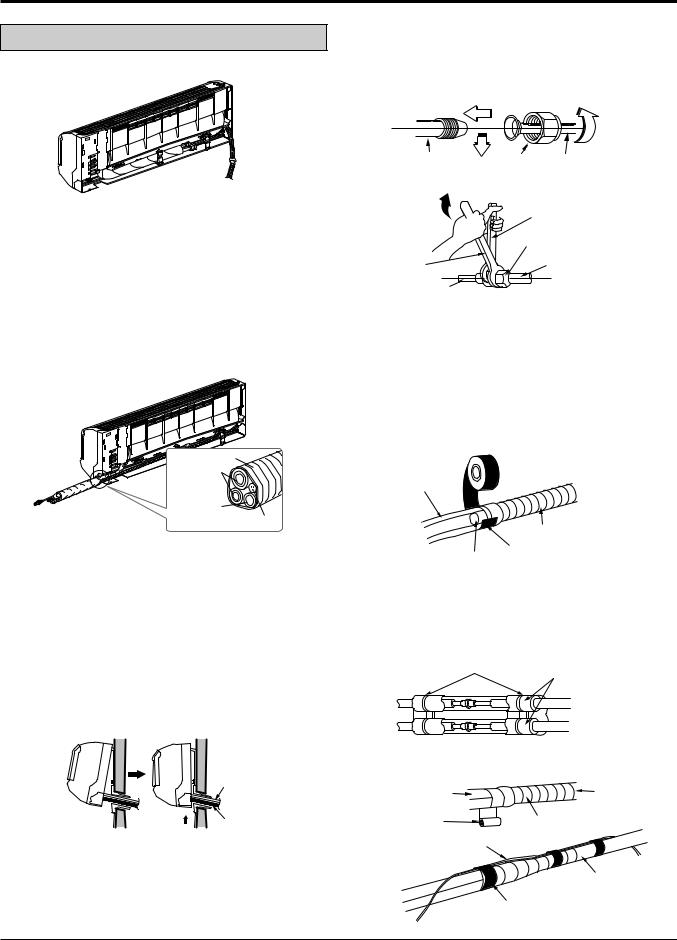
Flaring work and connection of piping
For right rear piping
Route the indoor tubing and the drain hose in the direction of rear right. 
Connecting the pipings to the indoor unit and drain hose to drain pipe.
•Align the center of the pipes and sufficiently tighten the flare nut by hand.
 Drain hose
Drain hose
Indoor unit tubing |
Flare nut Pipes |
• Tighten the flare nut with a wrench.
Insert the connecting cable into the indoor unit from the outdoor unit through the piping hole.
•Do not connect the cable to the indoor unit.
•Make a small loop with the cable for easy connection later.

 Open-end wrench (fixed)
Open-end wrench (fixed)
Flare nut
Wrench |
Connection pipe |
Indoor unit tubing
Tape the tubing, drain hose, and the connecting cable. Be sure that the drain hose is located at the lowest side of the bundle. Locating at the upper side can cause drain pan to overflow inside the unit.
Tape
Connecting pipe
Drain hose
Connecting cable
NOTE: If the drain hose is routed inside the room, insulate the hose with an insulation material* so that dripping from "sweating"(condensation) will not damage furniture or floors.
*Foamed polyethylene or equivalent is recommended.
Indoor unit installation
•Hook the indoor unit onto the upper portion of the installation plate.(Engage the two hooks of the rear top of the indoor unit with the upper edge of the installation plate.) Ensure that the hooks are properly seated on the installation plate by moving it left and right.
Connecting
cable
Drain hose
Press the lower left and right sides of the unit against the installation plate until the hooks engage into their slots(clicking sound).
Outside diameter |
Torque |
|
|
|
|
mm |
inch |
kg.m |
Ø6.35 |
1/4 |
1.8 |
Ø9.52 |
3/8 |
4.2 |
Ø12.7 |
1/2 |
5.5 |
Ø15.88 |
5/8 |
6.6 |
Ø19.05 |
3/4 |
6.6 |
•When extending the drain hose at the indoor unit, install the drain pipe.
Drain pipe
Indoor unit drain hose
Adhesive Vinyl tape(narrow)
Wrap the insulation material around the connecting portion.
•Overlap the connection pipe insulation material and the indoor unit pipe insulation material. Bind them together with vinyl tape so that there is no gap.
Plastic bands Insulation material
•Wrap the area which accommodates the rear piping housing section with vinyl tape.
Connection |
Indoor |
|
unit pipe |
||
pipe |
||
|
||
Vinyl tape |
Wrap with vinyl tape |
|
(wide) |
|
Service Manual 17

Flaring work and connection of piping
•Bundle the piping and drain hose together by wrapping them with vinyl tape for enough to cover where they fit into the rear piping housing section.
Wrap with vinyl tape
Pipe
 Vinyl tape(wide)
Vinyl tape(wide)
Drain hose
For left rear piping
Route the indoor tubing and the drain hose to the required piping hole position.
Insert the piping, drain hose, and the connecting cable into the piping hole.
Connecting cable
Drain pipe
Connecting the pipings to the indoor unit and the drain hose to drain pipe.
•Align the center of the pipes and sufficiently tighten the flare nut by hand.
Indoor unit tubing |
Flare nut Pipes |
• Tighten the flare nut with a wrench.
|
Open-end wrench (fixed) |
|
|
Flare nut |
|
Wrench |
|
Connection pipe |
Indoor unit tubing |
|
|
Outside diameter |
Torque |
|
mm |
inch |
kg.m |
Ø6.35 |
1/4 |
1.8 |
Ø9.52 |
3/8 |
4.2 |
Ø12.7 |
1/2 |
5.5 |
Ø15.88 |
5/8 |
6.6 |
Ø19.05 |
3/4 |
6.6 |
•When extending the drain hose at the indoor unit, install the drain pipe.
Insert the connecting cable into the indoor unit. |
|
• Don't connect the cable to the indoor unit. |
Drain hose |
|
|
• Make a small loop with the cable for easy connection later. |
|
Tape the drain hose and the connecting cable.
• Connecting cable
Indoor unit installation
•Hang the indoor unit from the hooks at the top of the installation plate.
•Insert the spacer etc. between the indoor unit and the installation plate and separate the bottom of the indoor unit from the wall.
Indoor unit
Spacer
Installation plate 8cm
Indoor unit drain hose
Adhesive Vinyl tape (narrow)
Wrap the insulation material around the connecting portion.
•Overlap the connection pipe heat insulation and the indoor unit pipe heat insulation material. Bind them together with vinyl tape so that there is no gap.
Plastic bands Insulation material
18 Room Air Conditioner
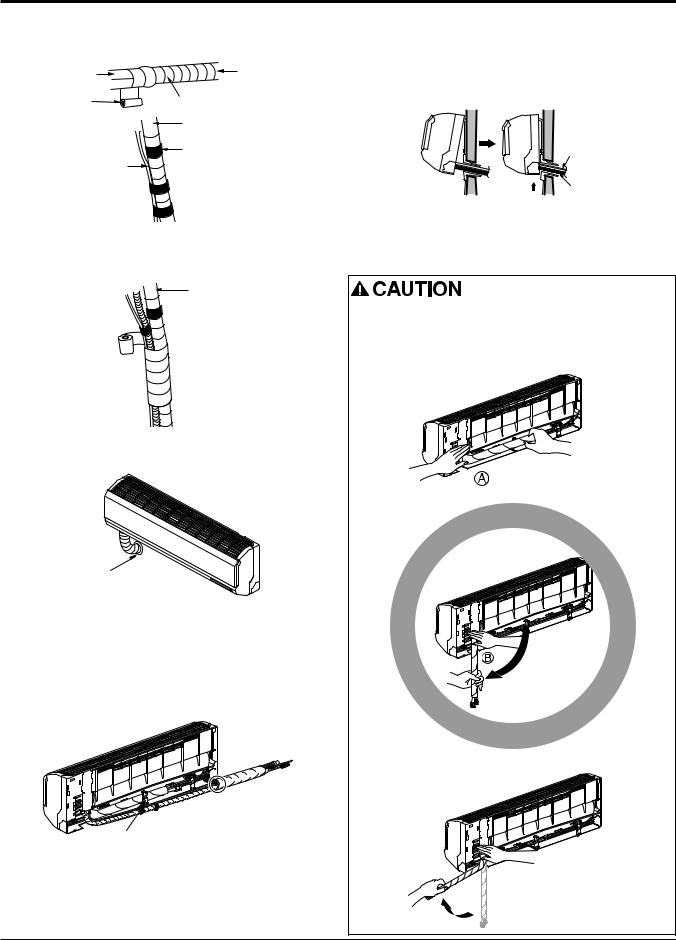
Flaring work and connection of piping
•Wrap the area which accommodates the rear piping housing section with vinyl tape.
Connection |
Indoor |
|
unit piping |
||
pipe |
||
|
||
Vinyl tape |
Wrap with vinyl tape |
|
(wide) |
|
|
|
Pipe |
|
|
Vinyl tape(narrow) |
|
Connecting cable |
|
• Bundle the piping and drain hose together by wrapping them with cloth tape over the range within which they fit into the rear piping housing section.
Pipe
Drain hose 
 Vinyl tape(narrow)
Vinyl tape(narrow)
 Wrap with
Wrap with
vinyl tape(wide)
Reroute the pipings and the drain hose across the back of the chassis.
Piping passage piping hole
Set the pipings and the drain hose to the back of the chassis with the tubing holder.
•Hook the edge of tubing holder to tap on chassis and push the bottom of tubing holder to be engaged at the bottom of chassis.
Tubing holder
Indoor unit installation
•Remove the spacer.
•Ensure that the hooks are properly seated on the installation plate by moving it left and right.
Connecting
cable
Drain hose
Press the lower left and right sides of the unit against the installation plate until the hooks engage into their slots(clicking sound).
Installation Information (For left piping)
•Good case
For left piping. Follow the instruction below.
•Press on the upper side of clamp. ( )
)
• Unfold the tubing to downward slowly. ( )
)
• Bend the tubing to the left side of chassis.
Service Manual 19

Flaring work and connection of piping
•Bad case
•Following bending type from right to left could cause problem of pipe damage.


 Connection
Connection

 of
of
 the
the
 pipes-
pipes-
 Outdoor
Outdoor





Align the center of the pipings and sufficiently tighten the flare nut by hand.
Finally, tighten the flare nut with torque wrench until the wrench clicks.
•When tightening the flare nut with torque wrench, ensure the direction for tightening follows the arrow on the wrench.
Outside diameter |
Torque |
|
|
|
|
mm |
inch |
kg.m |
Ø6.35 |
1/4 |
1.8 |
Ø9.52 |
3/8 |
4.2 |
Ø12.7 |
1/2 |
5.5 |
Ø15.88 |
5/8 |
6.6 |
Ø19.05 |
3/4 |
6.6 |
|
|
|
Outdoor unit
Gas side piping (Bigger diameter)
 Liquid side piping (Smaller diameter)
Liquid side piping (Smaller diameter)
Torque wrench
20 Room Air Conditioner

Connecting the cable between indoor unit and outdoor unit
Connecting the cable between indoor unit and outdoor unit

 Connect
Connect the cable
the cable to
to the
the Indoor unit.
Indoor unit.

































Connect the cable to the indoor unit by connecting the wires to the terminals on the control board individually according to the outdoor unit connection. (Ensure that the color of the wires of the outdoor unit and the terminal No. are the same as those of the indoor unit.)
•The above circuit diagram is subject to change without notice.
•The earth wire should be longer than the common wires.
•When installing, refer to the circuit diagram behind the panel front of the indoor unit.
•Connect the wires firmly so that they may not be pulled out easily.
•Connect the wires according to color codes, referring to the wiring diagram.
If a power plug is not used, provide a circuit breaker between power source and the unit as shown by.
Main power source
Air |
Circuit Breaker |
Conditioner |
Use a circuit |
|
breaker or time |
|
delay fuse. |
The power cord connected to the "A" unit should be selected according to the following specifications(Type "B" approved by HAR or SAA).
|
|
|
|
(mm2) |
|
NORMAL CROSS |
|
Grade |
|
||
|
|
|
|
||
7k |
9k~14k |
18k |
24k |
||
-SECTIONAL AREA |
|||||
|
|
|
|
||
0.75 |
1.0 |
1.5 |
2.5 |
||
|
|||||
|
|
|
|
|
|
Unit(A) |
Indoor |
Indoor |
Indoor |
Indoor |
|
|
|
|
|
|
|
Cable Type(B) |
H05VV-F |
H05VV-F |
H05VV-F |
H05VV-F |
|
|
|
|
|
|
|
The power connecting cable connecting the indoor and outdoor unit should be selected according to the following specifications (Type "B" approved by HAR or SAA).
|
|
|
|
(mm2) |
|
NORMAL CROSS |
|
Grade |
|
||
|
|
|
|
||
7k |
9k~14k |
18k |
24k |
||
-SECTIONAL AREA |
|||||
|
|
|
|
||
0.75 |
1.0 |
1.5 |
2.5 |
||
|
|||||
|
|
|
|
|
|
Cable Type(B) |
H07RN-F |
H07RN-F |
H07RN-F |
H07RN-F |
|
|
|
|
|
|
|
Service Manual 21
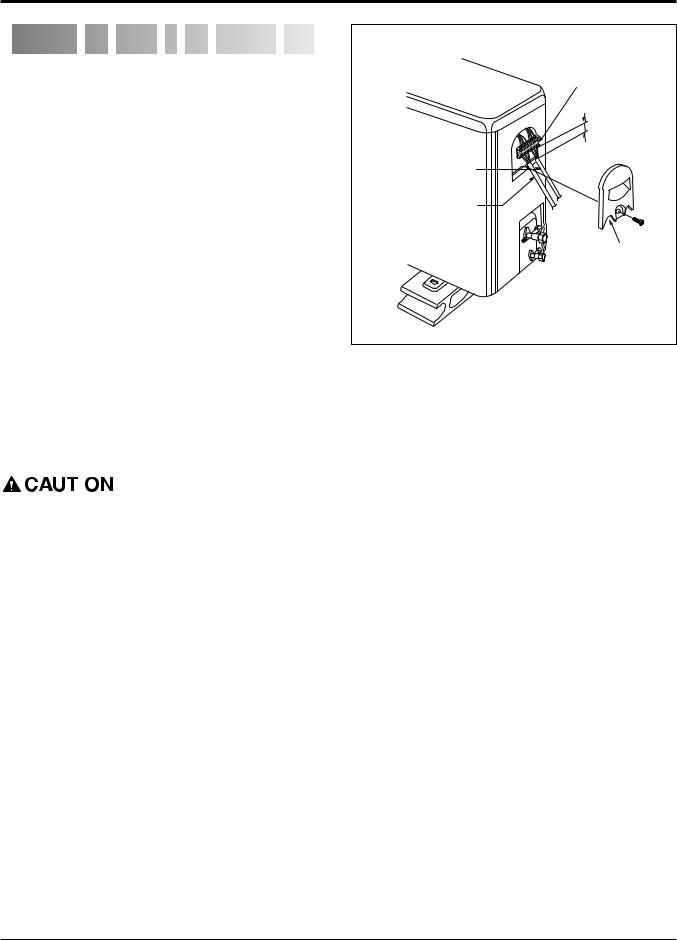
Connecting the cable between indoor unit and outdoor unit


 Connect
Connect
 the
the
 cable
cable
 to
to
 the
the
 outdoor
outdoor
 unit
unit






Remove the control cover from the unit by loosening the screw.
Connect the wires to the terminals on the control board individually.
Secure the cable onto the control board with the cord clamp.
Refix the control cover to the original position with the screw.
Use a recognized circuit breaker "A" between the power source and the unit.
A disconnecting device to adequately disconnect all supply lines must be fitted.
Circuit |
|
|
|
Grade |
|
|
|
Breaker |
5k~14k |
18k |
24k~28k |
30k, 32k |
36k, 38k |
||
(A) |
|
|
|
|
|
|
|
15 |
20 |
30 |
30 |
40 |
|||
|
|||||||
|
|
|
|
|
|
|
|
|
|
|
|
|
|
|
|
|
|
|
|
|
|
|
|
Outdoor Unit |
Terminal block |
Over 5mm |
Connecting cable |
Connecting cable |
Cover control |
After the confirmation of the above conditions, prepare the wiring as follows:
1)Never fail to have an individual power circuit specifically for the air conditioner. As for the method of wiring, be guided by the circuit diagram posted on the inside of control cover.
2)The screw which fasten the wiring in the casing of electrical fittings are liable to come loose from vibrations to which the unit is subjected during the course of transportation. Check them and make sure that they are all tightly fastened. (If they are loose, it could cause burn-out of the wires.)
3)Specification of power source.
4)Confirm that electrical capacity is sufficient.
5)See to that the starting voltage is maintained at more than 90 percent of the rated voltage marked on the name plate.
6)Confirm that the cable thickness is as specified in the power source specification. (Particularly note the relation between cable length and thickness. (Refer to page 21))
7)Always install an earth leakage circuit breaker in a wet or moist area.
8)The following would be caused by voltage drop.
•Vibration of a magnetic switch, which will damage the contact point, fuse breaking, disturbance of the normal function of the overload.
9)The means for disconnection from a power supply shall be incorporated in the fixed wiring and have an air gap contact separation of at least 3mm in each active(phase) conductors.
22 Room Air Conditioner
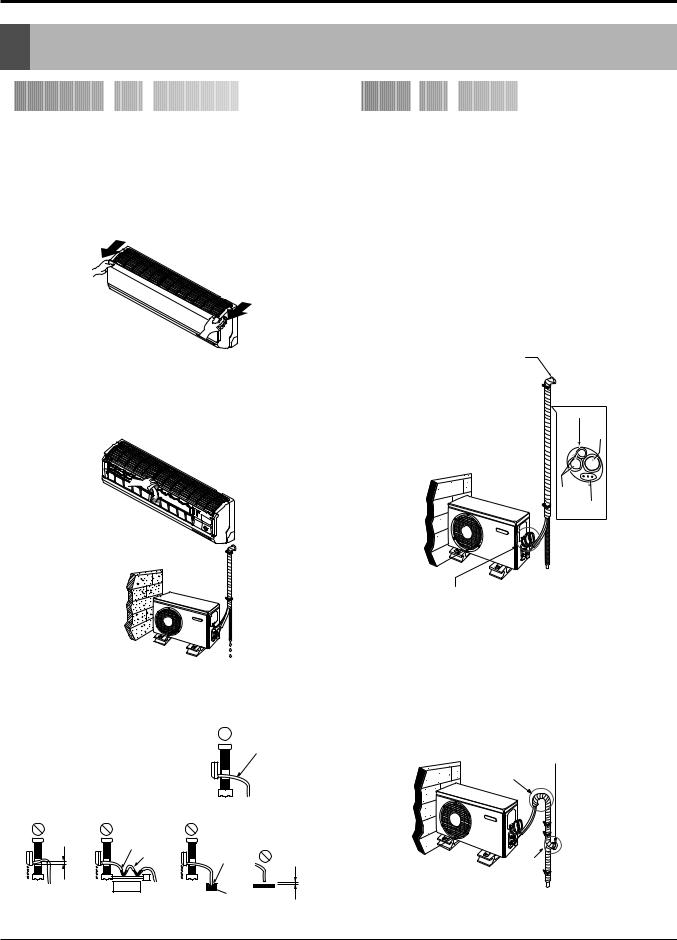
Checking the drainage and forming the pipings
Checking the drainage and forming the pipings


 Checking
Checking


 the
the
 drainage
drainage






















To remove the front panel from the indoor unit.
•Set the air direction louvers up-and-down to the position(horizontally) by hand.
•Remove the securing screws that retain the front panel. Pull the lower left and right sides of the grille toward you and lift it off.


 Form
Form

 the
the

 piping
piping





































Form the piping by wrapping the connecting portion of the indoor unit with insulation material and secure it with two kinds of vinyl tapes.
•If you want to connect an additional drain hose, the end of the drain outlet should be routed above the ground. Secure the drain hose appropriately.
Pull the right and the left side.
To check the drainage.
•Pour a glass of water on the evaporator.
•Ensure the water flows through the drain hose of the indoor unit without any leakage and goes out the drain exit.
Drain piping
• The drain hose should point downward for easy drain flow.
Downward slope
• Do not make drain piping.
|
Do not raise |
|
Accumulated |
|
|
|
|
|
drain water |
|
|
|
|
|
|
|
|
Tip of drain hose |
|
|
|
|
|
Air |
|
Less than |
|
|
|
|
|
|
dipped in water |
|
|
|
|
|
|
50mm gap |
|
|
|
|
|
|
|
|
Water |
|
Water |
Waving |
Water |
|
|
leakage |
|
leakage |
leakage |
Ditch |
|
|
|
|
|
||||
|
|
|
|
|
|
In cases where the outdoor unit is installed below the indoor unit perform the following.
•Tape the piping, drain hose and connecting cable from down to up.
•Secure the tapped piping along the exterior wall using saddle or equivalent.
Seal small openings around pipings with a gum type sealer.
Taping
Drain hose
Pipings
Connecting cable
 Trap is required to prevent water from entering into electrical parts.
Trap is required to prevent water from entering into electrical parts.
In cases where the Outdoor unit is installed above the Indoor unit perform the following.
•Tape the piping and connecting cable from down to up.
•Secure the taped piping along the exterior wall. Form a trap to prevent water entering the room.
•Fix the piping onto the wall by saddle or equivalent.
Seal a small opening around the pipings with gum type sealer.
Trap
Trap
Service Manual 23

Air purging
Air Purging


 Air
Air

 purging
purging
















































Air and moisture remaining in the refrigerant system have undesirable effects as indicated below.
•Pressure in the system rises.
•Operating current rises.
•Cooling(or heating) efficiency drops.
•Moisture in the refrigerant circuit may freeze and block capillary tubing.
•Water may lead to corrosion of parts in the refrigeration system.
Therefore, the indoor unit and tubing between the indoor and outdoor unit must be leak tested and evacuated to remove any noncondensables and moisture from the system.


 Air
Air

 purging
purging
 with
with
 vacuum
vacuum

 pump
pump





Preparation
•Check that each tube(both liquid and gas side tubes) between the indoor and outdoor units have been properly connected and all wiring for the test run has been completed. Remove the service valve caps from both the gas and the liquid side on the outdoor unit. Note that both the liquid and the gas side service valves on the outdoor unit are kept closed at this stage.
Leak test
•Connect the manifold valve(with pressure gauges) and dry nitrogen gas cylinder to this service port with charge hoses.
Be sure to use a manifold valve for air purging. If it is not available, use a stop valve for this purpose. The "Hi" knob of the manifold valve must always be kept close.
•Pressurize the system to no more than 150 P.S.I.G. with dry nitrogen gas and close the cylinder valve when the gauge reading reached 150 P.S.I.G. Next, test for leaks with liquid soap.
•Do a leak test of all joints of the tubing(both indoor and outdoor) and both gas and liquid side service valves.
Bubbles indicate a leak. Be sure to wipe off the soap with a clean cloth.
•After the system is found to be free of leaks, relieve the nitrogen pressure by loosening the charge hose connector at the nitrogen cylinder. When the system pressure is reduced to normal, disconnect the hose from the cylinder.
Outdoor unit
Manifold valve
Pressure 

 gauge
gauge 

 Lo Hi
Lo Hi
Charge hose
To avoid nitrogen entering the refrigerant system in a liquid state, the top of the cylinder must be higher than its bottom when you pressurize the system. Usually, the cylinder is used in a vertical standing position.
Nitrogen gas cylinder(in vertical standing position)
24 Room Air Conditioner
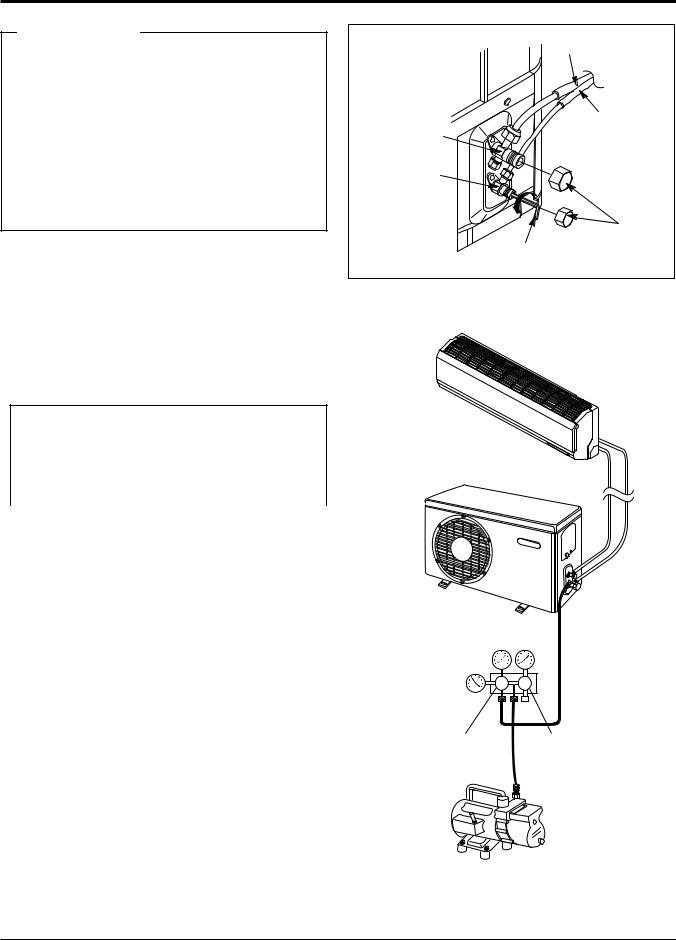
Air purging
Soap water method
(1)Remove the caps from the 2-way and 3-way valves.
(2)Remove the service-port cap from the 3-way valve.
(3)To open the 2-way valve turn the valve stem counterclockwise approximately 90°, wait for about 2~3 sec, and close it.
(4)Apply a soap water or a liquid neutral detergent on the indoor unit connection or outdoor unit connections by a soft brush to check for leakage of the connecting points of the piping.
(5)If bubbles come out, the pipes have leakage.
Evacuation
•Connect the charge hose end described in the preceding steps to the vacuum pump to evacuate the tubing and indoor unit.
Confirm the "Lo" knob of the manifold valve is open. Then, run the vacuum pump.
The operation time for evacuation varies with tubing length and capacity of the pump. The following table shows the time required for evacuation.
Required time for evacuation when 30 gal/h vacuum pump is used
If tubing length is less than 10m (33 ft) |
if tubing length is longer than 10m (33 ft) |
|
|
10 min. or more |
15 min. or more |
|
|
•When the desired vacuum is reached, close the "Lo" knob of the manifold valve and stop the vacuum pump.
Finishing the job
•With a service valve wrench, turn the valve stem of liquid side valve counter-clockwise to fully open the valve.
•Turn the valve stem of gas side valve counter-clockwise to fully open the valve.
•Loosen the charge hose connected to the gas side service port slightly to release the pressure, then remove the hose.
•Replace the flare nut and its bonnet on the gas side service port and fasten the flare nut securely with an adjustable wrench. This process is very important to prevent leakage from the system.
•Replace the valve caps at both gas and liquid side service valves and fasten them tight.
This completes air purging with a vacuum pump. The air conditioner is now ready to test run.
Gas side
Liquid side
3-way valve (Close)
2-way valve (Open)
Cap
Hexagonal wrench
Outdoor unit
Manifold
Pressure gauge
Open Close
Vacuum pump
Service Manual 25
